The Marshall Star for April 17, 2024
The Full Experience: NASA, Marshall, and Arkansas Celebrate Total Solar Eclipse By Celine Smith More than 100,000 people from across the world gathered April 8 in Russellville, Arkansas, to witness an astronomical syzygy – the alignment of the Sun, Moon, and Earth – creating a solar eclipse with totality lasting 4 minutes and 12 seconds. […]
The Marshall Star for April 17, 2024
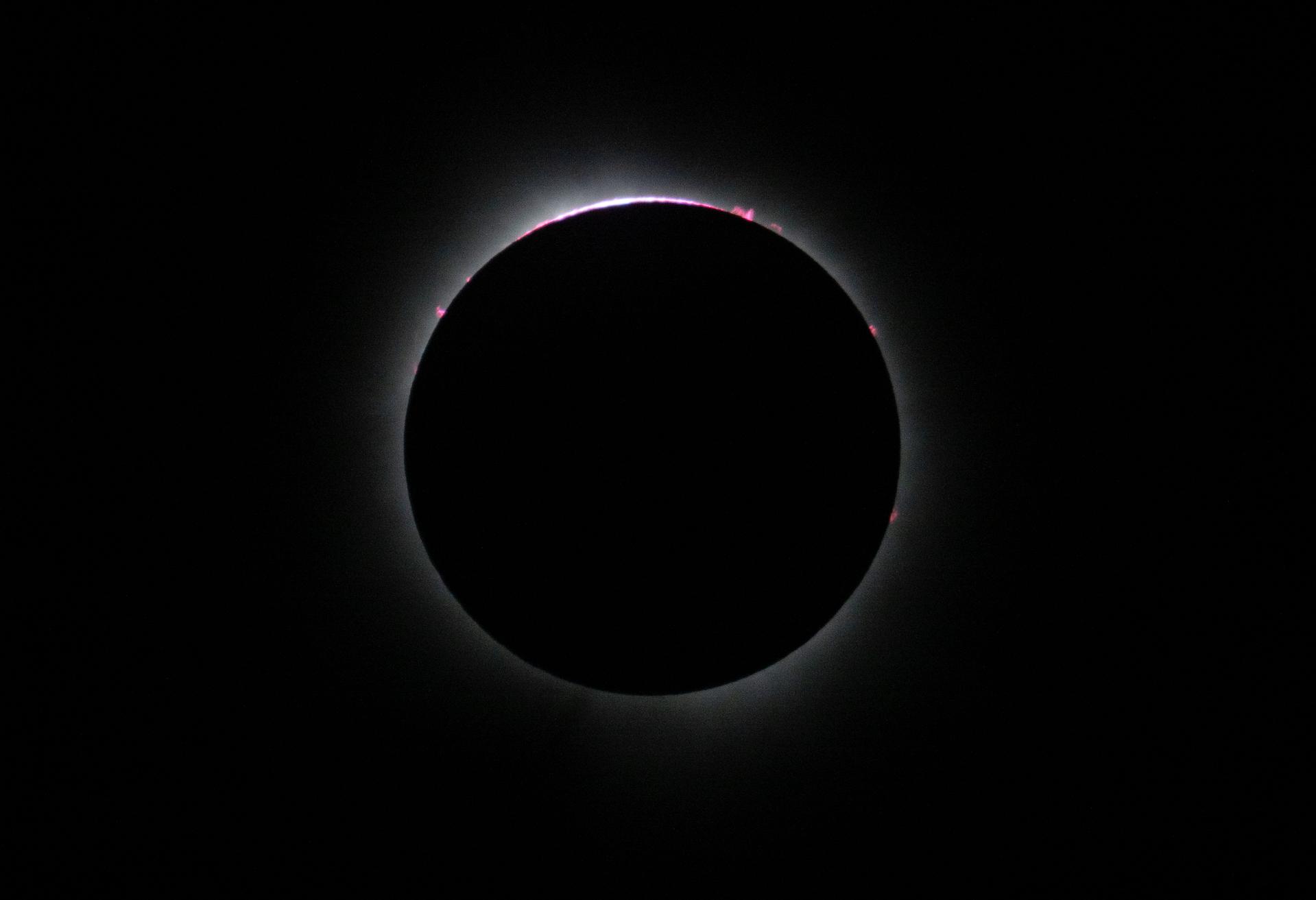
The Full Experience: NASA, Marshall, and Arkansas Celebrate Total Solar Eclipse
By Celine Smith
More than 100,000 people from across the world gathered April 8 in Russellville, Arkansas, to witness an astronomical syzygy – the alignment of the Sun, Moon, and Earth – creating a solar eclipse with totality lasting 4 minutes and 12 seconds.
Team members from NASA’s Marshall Space Flight Center and others traveled to Arkansas to provide educational opportunities related to the eclipse. Experts from NASA’s Stennis Space Center, Kennedy Space Center, and NASA Headquarters, along with representatives of the Arkansas Air National Guard and the Paris Observatory in Muedon, France, joined the Marshall team.

“I’ve conducted outreach before, but nothing on this scale,” said Patrick Koehn, heliophysics research and analysis lead at NASA Headquarters. “The logistics were on another level, it was impressive to see it come together, and I’m thrilled we engaged so many people.”
In the days leading up to the eclipse, NASA hosted exhibits and outreach activities for the public and gave presentations for students at Arkansas Tech University and the Russellville School District. Visitors were also given an opportunity to meet retired NASA astronaut Mike Massimino, who signed autographs and greeted the crowds.

Marshall Center Director Joseph Pelfrey also attended this celestial experience, giving remarks at the Russellville watch party about the eclipse and the work of Marshall’s Heliophysics and Planetary Science Branch.
“Thanks to our collaboration with the city of Russellville, we helped host one of the agency’s most successful eclipse events,” Pelfrey said. “People came from across the nation and the world to share the experience with us. It was incredible to witness my first total solar eclipse alongside the Marshall team in Arkansas.”
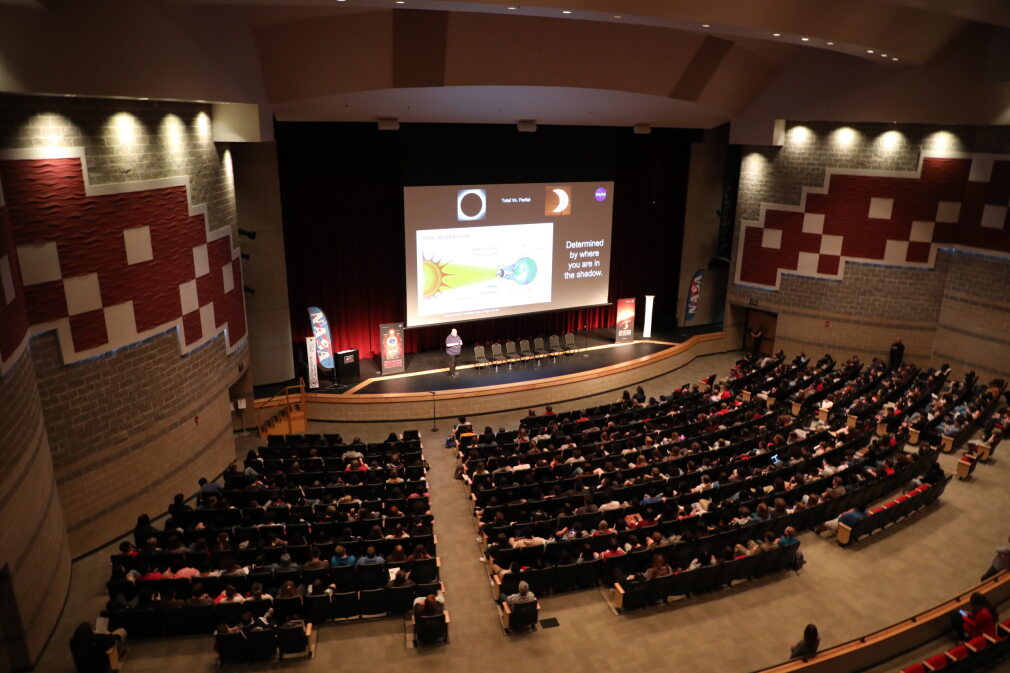
Russellville was one of the cities featured in NASA’s live eclipse broadcast, 2024 Total Solar Eclipse: Through the Eyes of NASA. The three-hour broadcast covered the path of the eclipse across 15 states, from Texas to Maine, garnering more than one million live viewers. Currently, the broadcast has more than 13 million views. Russellville was noted for its clear skies, providing spectators with one of the most visible sightings of the eclipse.
The 2024 solar eclipse was especially spectacular due to the prominences visible during totality. Solar protected cameras captured the fiery red arcs around the edge of the Moon and Sun.
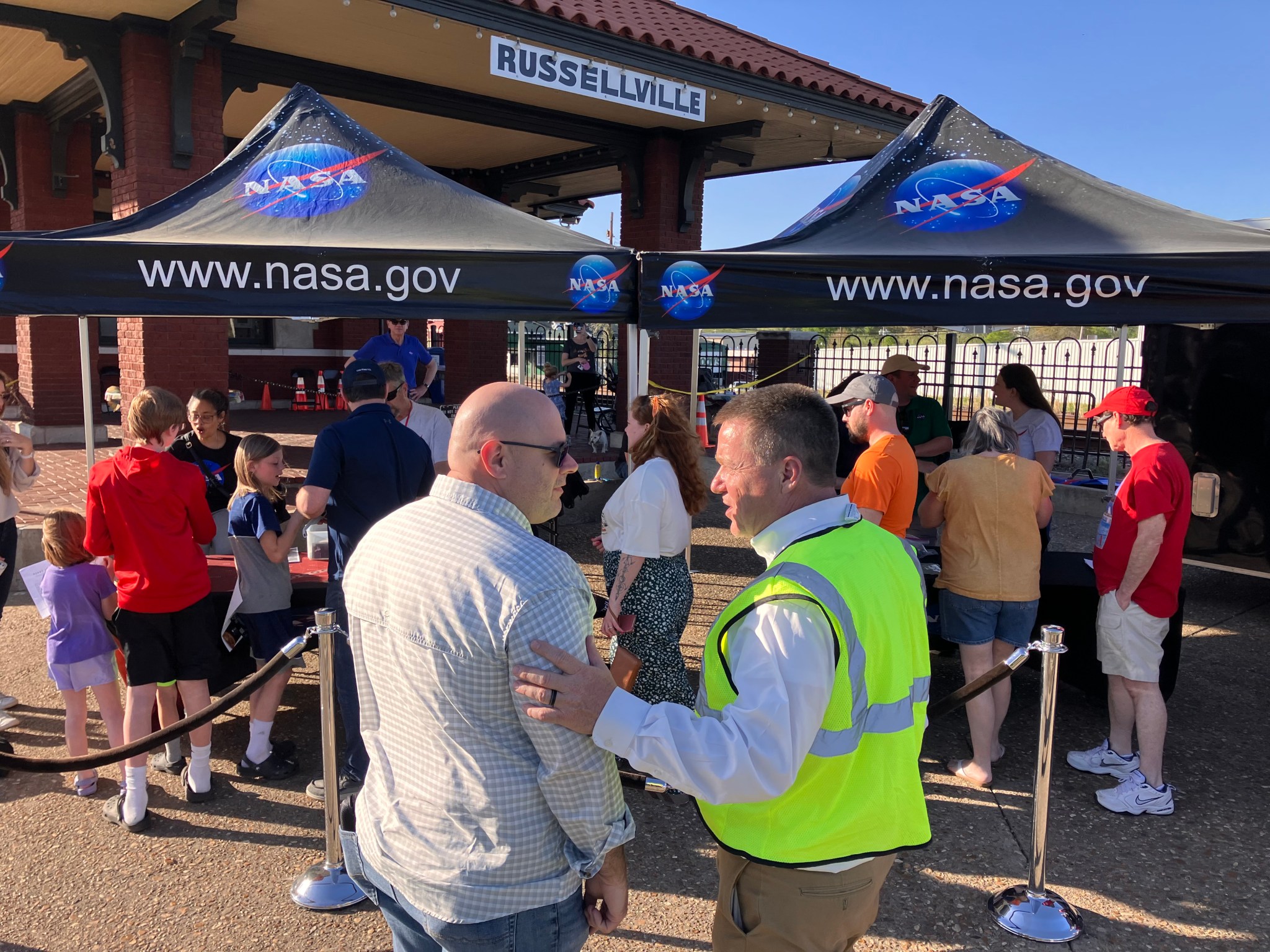
“This was my first total solar eclipse, and it was an awesome experience,” said Bob Loper, research astrophysicist at Marshall. “It was incredible to see phenomena I’ve spent my career studying – actually seeing solar prominences of the Sun was an experience I’ll never forget.”
View more photos of the April 8 eclipse from NASA.
Smith, a Media Fusion employee, supports the Marshall Office of Communications.
Chad Summers Named Director of Test Laboratory for Marshall’s Engineering Directorate
Chad Summers has been named as the director of the Test Laboratory for the Engineering Directorate at NASA’s Marshall Space Flight Center, effective April 21.
An integral part of the Engineering Directorate, the Test Laboratory encompasses a wide range of specialized capabilities NASA uses to conduct testing for space flight hardware research, development, qualification, acceptance, and anomaly resolution. As director, Summers will provide executive leadership for all aspects of the Laboratory, including workforce, budget, infrastructure, and operations for testing.

Summers has been the chief of the Structural Design and Analysis Division at Marshall since 2019. In that role, he supervised a division of civil service and contractor engineers to assure the successful design, development, and integration of large, complex launch vehicles and spacecraft systems to meet NASA’s Human Exploration and Science Mission objectives. From 2018 to 2019, Summers was the division’s deputy chief.
From 2015 to 2018, he was chief of the Systems Requirements and Verification branch. Summers led the Systems Design and Definition branch from 2011 to 2015. From 2007 to 2011, he was chief of the Systems Requirements, Interfaces, and Verification branch. Summers was deputy chief of the Engine Systems and Main Propulsion Systems branch from 2004 to 2007.
Summers has almost 30 years of experience at NASA and worked at both Kennedy Space Center and Stennis Space Center prior to coming to Marshall in 2001 as a test operations manager in the Next Generation Launch Technology Project Office.
He has received several of the agency’s highest awards, including NASA’s Outstanding Leadership Medal, Exceptional Service Medal, Marshall Director’s Commendation, and multiple Group Achievement and Special Service awards.
A native of Titusville, Florida, Summers received his bachelor’s degree in mechanical engineering from the University of Central Florida. He lives in Huntsville with his wife, Jennifer.
Public Invited to NASA’s 30th Anniversary of International Rover Competition
NASA will celebrate the 30th anniversary of the Human Exploration Rover Challenge when the competition returns to the U.S. Space & Rocket Center’s Aviation Challenge Course in Huntsville April 19-20. The event is free and open to the public with rover excursions occurring each day from 7:30 a.m. to 3 p.m. or until the last rover completes the obstacle course.
NASA selected 72 student teams in October to begin an engineering design challenge to build human-powered rovers that will compete at the course near the agency’s Marshall Space Flight Center.
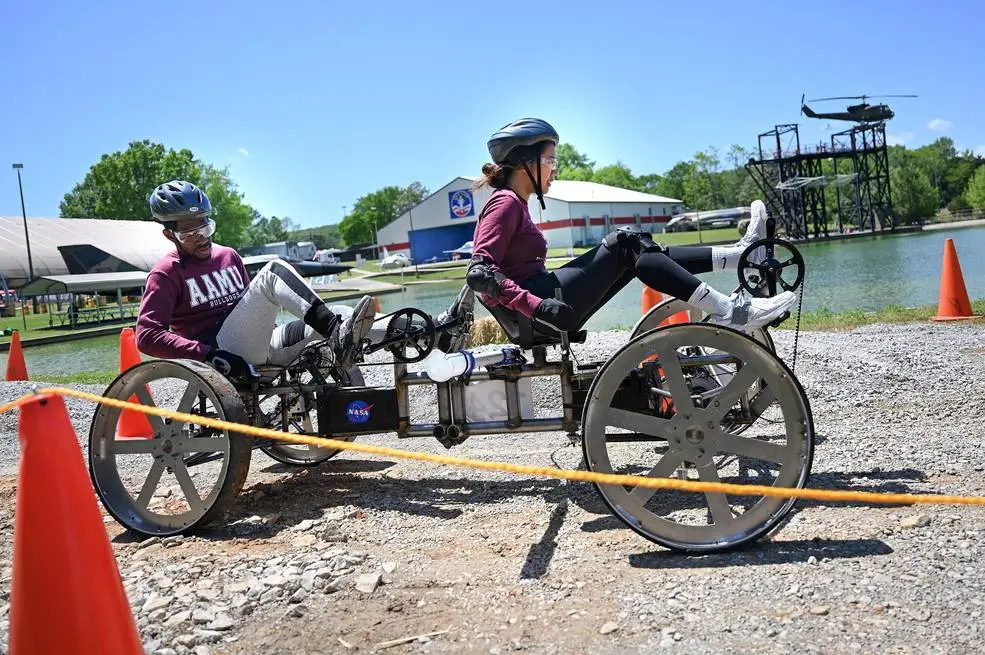
The public is invited to watch more than 600 students from around the world attempt to navigate a complex obstacle course by piloting a human-powered vehicle of their own design and production.
Participating teams represent 42 colleges and universities and 30 high schools from 24 states, the District of Columbia, Puerto Rico, and 13 other nations from around the world. NASA’s handbook has complete proposal guidelines and task challenges.
To conclude the 2024 season, NASA will host an in-person awards ceremony April 20 at 5 p.m. inside the Space Camp Operations Center at the rocket center. NASA and industry representatives will present multiple awards highlighting team successes throughout the past eight-month-long engineering design project, including awards for best rover design, best pit crew award, best social media presence, and many other accomplishments.
The Human Exploration Rover Challenge tasks high school, college, and university students around the world to design, build, and test their lightweight, human-powered rovers on a course simulating lunar and Martian terrain, all while completing mission-focused science tasks. Eligible teams compete to be among the top three finishers in their divisions, and to win awards for best vehicle design, best rookie team, and more.
The challenge annually draws hundreds of students from around the world and reflects the goals of NASA’s Artemis campaign, which will land the first woman and first person of color on the Moon.
The event was launched in 1994 as the NASA Great Moonbuggy Race – a collegiate competition to commemorate the 25th anniversary of the Apollo 11 lunar landing. It expanded in 1996 to include high school teams, evolving again in 2014 into the NASA Human Exploration Rover Challenge. Since its inception, more than 15,000 students have participated. Many former competitors now work in the aerospace industry, including with NASA.
The Human Exploration Rover Challenge is managed by NASA’s Southeast Regional Office of STEM Engagement at Marshall and is one of eight Artemis Student Challenges. NASA’s Office of STEM Engagement uses challenges and competitions to further the agency’s goal of encouraging students to pursue degrees and careers in science, technology, engineering, and mathematics.
First-of-its-kind SLS Payload Adapter Finishes Assembly at Marshall
Teams at NASA’s Marshall Space Flight Center completed a new payload adapter test article and readied it for structural testing, set to begin later this spring. This marks a critical milestone on the journey to the hardware’s debut on the upgraded Block 1B configuration of NASA’s SLS (Space Launch System) rocket with Artemis IV.
The composite payload adapter is an evolution from the Orion stage adapter used in the Block 1 configuration of the first three Artemis missions.
Find out more about SLS.
Altitude Chamber Gets Upgrade for Artemis II, Spacecraft Testing Begins
Before the Orion spacecraft is stacked atop NASA’s powerful SLS (Space Launch System) rocket ahead of the Artemis II mission, engineers will put it through a series of rigorous tests to ensure it is ready for lunar flight. In preparation for testing, teams at the agency’s Kennedy Space Center have made significant upgrades to the altitude chamber where testing will occur.
Several of the tests take place inside one of two altitude chambers in the high bay of the Neil A. Armstrong Operations and Checkout (O&C) Building at Kennedy. These tests, which began on April 10, include checking out electromagnetic interference and electromagnetic compatibility, which demonstrate the capability of the spacecraft when subjected to internally and externally generated electromagnetic energy and verify that all systems perform as they would during the mission.
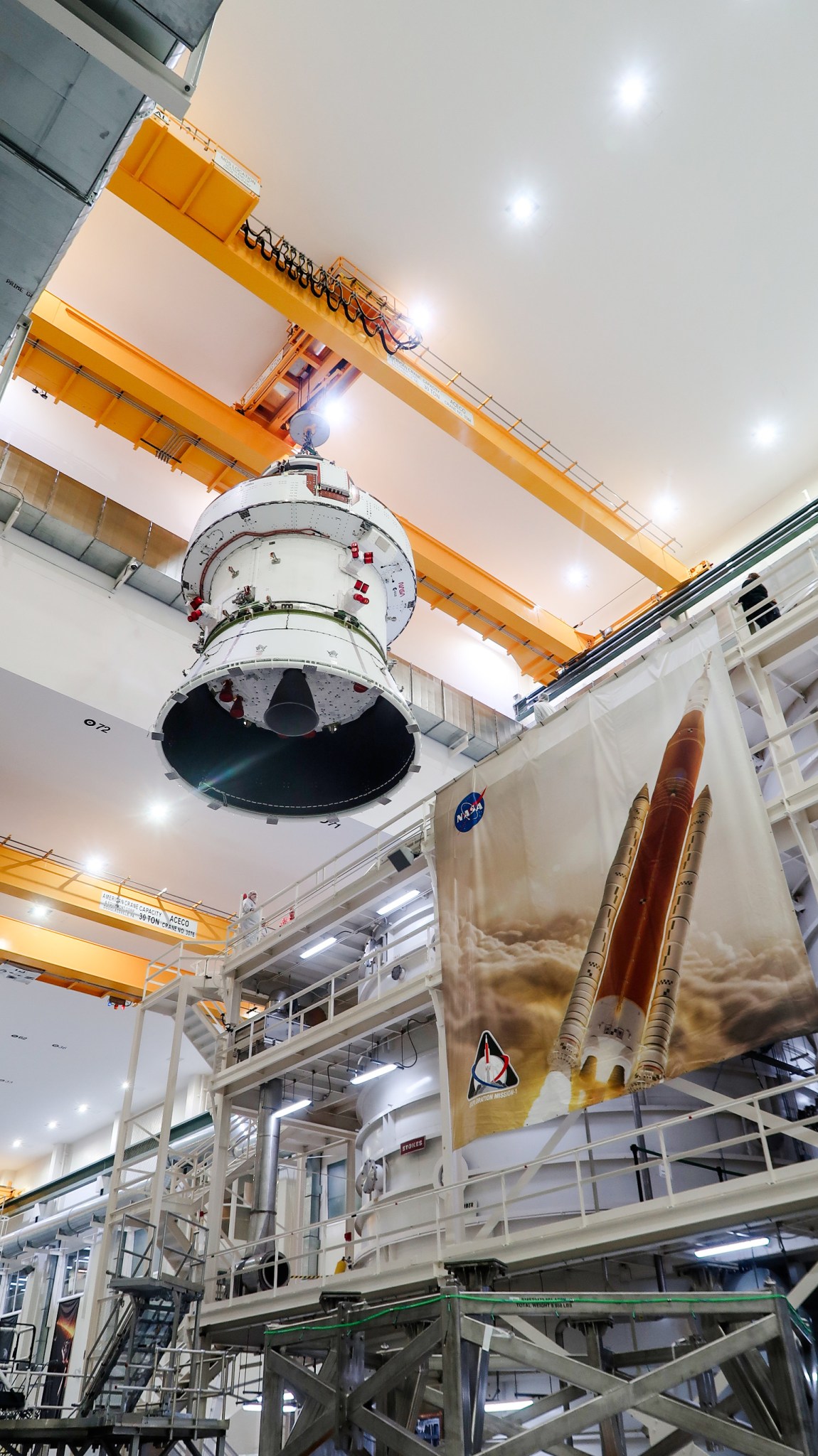
To prepare for the tests, the west altitude chamber was upgraded to test the spacecraft in a vacuum environment that simulates an altitude of up to 250,000 feet. These upgrades re-activated altitude chamber testing capabilities for the Orion spacecraft at Kennedy. Previous vacuum testing on the Orion spacecraft for Artemis I took place at NASA’s Glenn Research Center. Teams also installed a 30-ton crane in the O&C to lift and lower the Orion crew and service module stack into the chamber, lift and lower the chamber’s lid, and move the spacecraft across the high bay.
On April 4, teams loaded the Artemis II spacecraft into the altitude chamber. This event marks the first time, since the Apollo testing, that a spacecraft designed for human exploration of space has entered the chamber for testing. After testing is complete, the spacecraft will return to the Final Assembly and Systems Testing, or FAST, cell in the O&C for further work. Later this summer, teams will lift Orion back into the altitude chamber to conduct a test that simulates as close as possible the conditions in the vacuum of deep space.
Originally used to test environmental and life support systems on the lunar and command modules during the Apollo Program, the interior of each altitude chamber measures 33 feet in diameter and 44 feet high and was designed to simulate the vacuum equivalent of up to 200,000 feet in a deep space environment. Both chambers were rated for astronaut crews to operate flight systems during tests.
After Apollo, the chambers were used for leak tests on pressurized modules delivered by the Space Shuttle Program for the International Space Station.
Additional upgrades to the west chamber include a new oxygen deficiency monitoring system that provides real-time monitoring of the oxygen levels and a new airflow system. New LED lights replaced the previous lighting system, and equipment from the Apollo days was removed. A pressure control system was added to the chamber that provides precise control of pressure levels. Two new pumps remove the air from the chamber to create a vacuum. New guardrails and service platforms replaced the older platforms inside the chamber.
A new control room overlooks the upgraded chamber. It contains several workstations and communication equipment. The chamber control and monitoring system was upgraded to handle operation of all the remotely controlled hardware and subsystems that make up the vacuum testing capability.
“It was an amazing opportunity to lead a diverse and exceptional team to re-activate a capability for testing the NASA’s next generation spacecraft that will carry humans back to the Moon,” said Marie Reed, West Altitude Chamber Reactivation Project Manager. “The team of more than 70 aerospace professionals, included individuals from NASA, Lockheed Martin, Artic Slope Research Corps, Jacobs Engineering, and every discipline area imaginable. This project required long hours of dedication and exceptional coordination to enable the successful turn-around and activation in time for this Artemis II spacecraft testing.”
NASA’s Artemis II mission will carry four astronauts aboard the agency’s Orion spacecraft on an approximately 10-day test flight around the Moon and back to Earth, the first crewed flight under Artemis that will test Orion’s life support systems ahead of future missions. Under the Artemis campaign, NASA will return humanity to the lunar surface, this time sending humans to explore the lunar South Pole region.
For time lapse footage of the Artemis II lift into the vacuum chamber visit: Artemis II Orion Vac Chamber Lift and Load Operations
Media Get Close-Up of NASA’s Jupiter-Bound Europa Clipper
Engineers at NASA’s Jet Propulsion Laboratory are running final tests and preparing the agency’s Europa Clipper spacecraft for the next leg of its journey: launching from NASA’s Kennedy Space Center. Europa Clipper, which will orbit Jupiter and focus on the planet’s ice-encased moon Europa, is expected to leave JPL later this spring. Its launch period opens Oct. 10.
Members of the media put on “bunny suits” – outfits to protect the massive spacecraft from contamination – to see Europa Clipper up close in JPL’s historic Spacecraft Assembly Facility on April 11. Project Manager Jordan Evans, Launch-to-Mars Mission Manager Tracy Drain, Project Staff Scientist Samuel Howell, and Assembly, Test, and Launch Operations Cable Harness Engineer Luis Aguila were on the clean room floor, while Deputy Project Manager Tim Larson, and Mission Designer Ricardo Restrepo were in the gallery above to explain the mission and its goals.
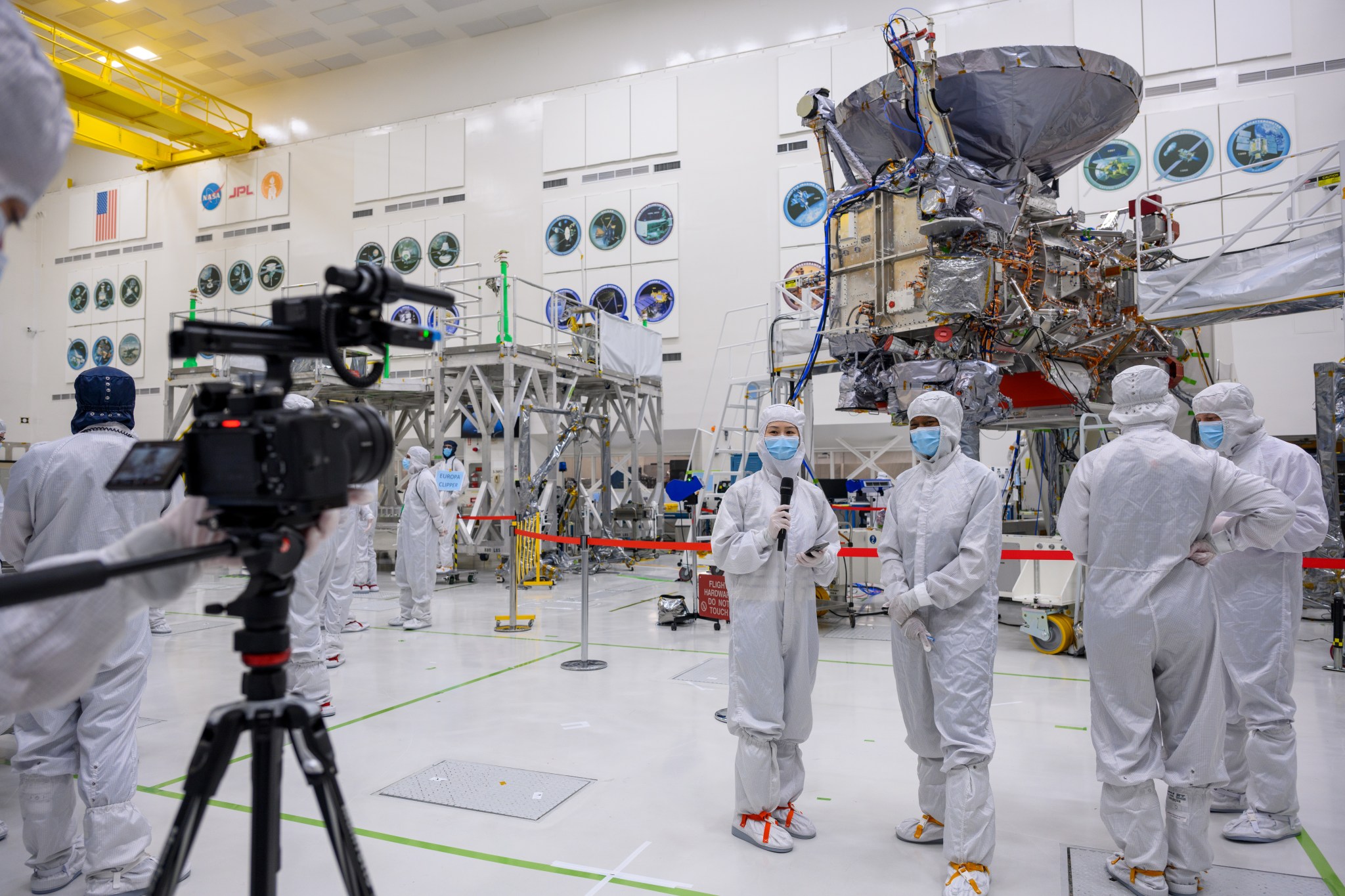
Planning of the mission began in 2013, and Europa Clipper was officially confirmed by NASA as a mission in 2019. The trip to Jupiter is expected to take about six years, with flybys of Mars and Earth. Reaching the gas giant in 2030, the spacecraft will orbit Jupiter while flying by Europa dozens of times, dipping as close as 16 miles from the moon’s surface to gather data with its powerful suite of science instruments. The information will help scientists learn about the ocean beneath the moon’s icy shell, map Europa’s surface composition and geology, and hunt for any potential plumes of water vapor that may be venting from the crust.
“After over a decade of hard work and problem-solving, we’re so proud to show the nearly complete Europa Clipper spacecraft to the world,” Evans said. “As critical components came in from institutions across the globe, it’s been exciting to see parts become a greater whole. We can’t wait to get this spacecraft to the Jupiter system.”
At the event, a cutaway model showing the moon’s layers and a globe of the moon helped journalists learn why Europa is such an interesting object of study. On hand with the details were Project Staff Scientist and Assistant Science Systems Engineer Kate Craft from the Johns Hopkins Applied Physics Laboratory in Laurel, Maryland, and, from JPL, Project Scientist Robert Pappalardo, Deputy Project Scientist Bonnie Buratti, and Science Communications Lead Cynthia Phillips.
Beyond Earth, Europa is considered one of the most promising potentially habitable environments in our solar system. While Europa Clipper is not a life-detection mission, its primary science goal is to determine whether there are places below the moon’s icy surface that could support life.
When the main part of the spacecraft arrives at Kennedy Space Center in a few months, engineers will finish preparing Europa Clipper for launch on a SpaceX Falcon Heavy rocket, attaching its giant solar arrays and carefully tucking the spacecraft inside the capsule that rides on top of the rocket. Then Europa Clipper will be ready to begin its space odyssey.
Europa Clipper’s three main science objectives are to determine the thickness of the moon’s icy shell and its surface interactions with the ocean below, to investigate its composition, and to characterize its geology. The mission’s detailed exploration of Europa will help scientists better understand the astrobiological potential for habitable worlds beyond our planet.
Managed by Caltech in Pasadena, California, JPL leads the development of the Europa Clipper mission in partnership with the Johns Hopkins Applied Physics Laboratory (APL) for NASA’s Science Mission Directorate. APL designed the main spacecraft body in collaboration with JPL and NASA’s Goddard Space Flight Center. The Planetary Missions Program Office at NASA’s Marshall Space Flight Center executes program management of the Europa Clipper mission.
Hubble Spots a Galaxy Hidden in a Dark Cloud
The subject of an image taken with the NASA/ESA Hubble Space Telescope is the spiral galaxy IC 4633, located 100 million light-years away from us in the constellation Apus. IC 4633 is a galaxy rich in star-forming activity and hosts an active galactic nucleus at its core. From our point of view, the galaxy is tilted mostly towards us, giving astronomers a fairly good view of its billions of stars.
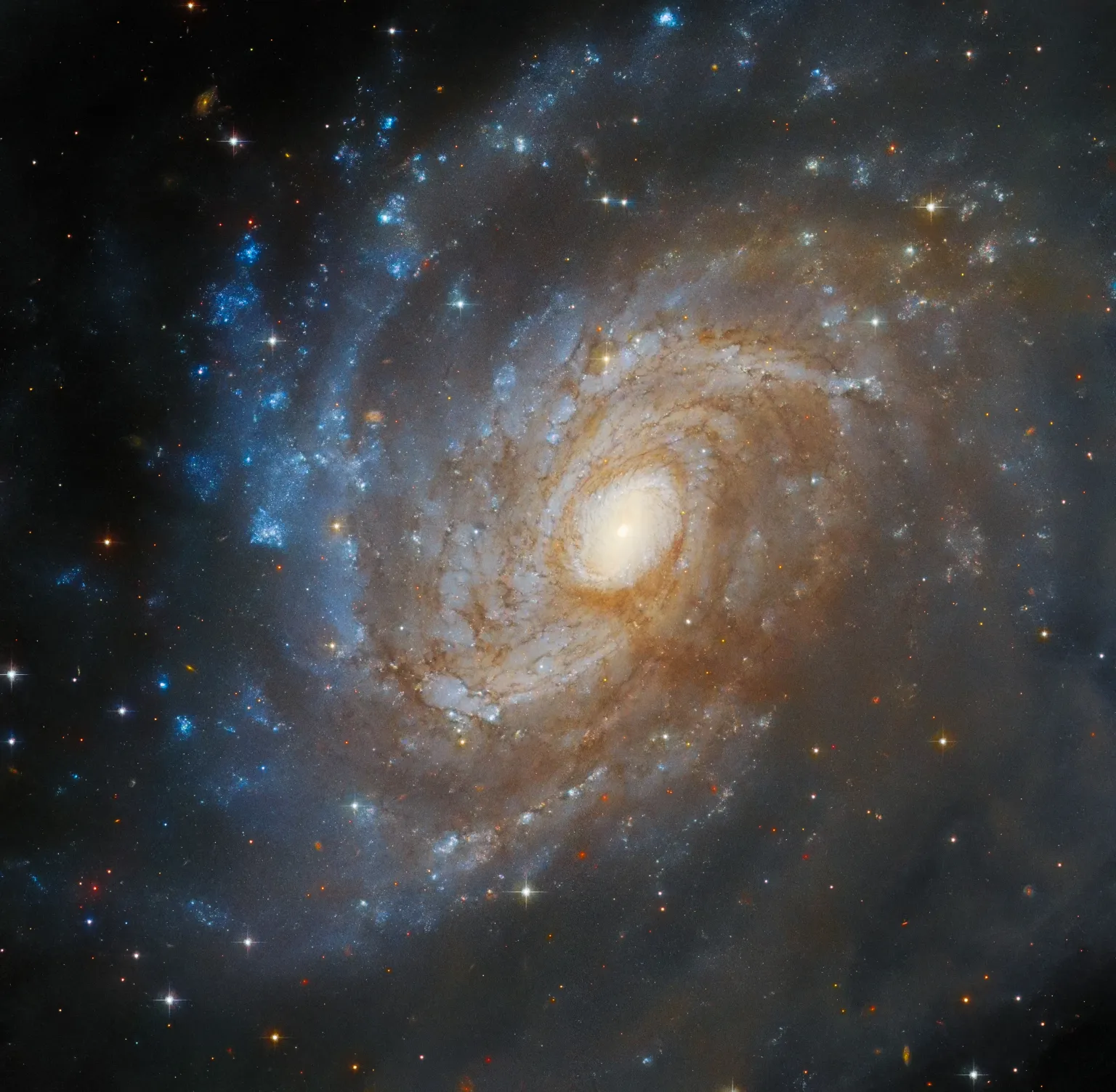
However, we can’t fully appreciate the features of this galaxy – at least in visible light – because it’s partially concealed by a stretch of dark dust (lower-right third of the image). This dark nebula is part of the Chamaeleon star-forming region, itself located only around 500 light-years from us, in a nearby part of our Milky Way galaxy. The dark clouds in the Chamaeleon region occupy a large area of the southern sky, covering their namesake constellation but also encroaching on nearby constellations, like Apus. The cloud is well-studied for its treasury of young stars, particularly the cloud Cha I, which both Hubble and the NASA/ESA/CSA James Webb Space Telescope have imaged.
The cloud overlapping IC 4633 lies east of the well-known Cha I, II, and III, and is also known as MW9 and the South Celestial Serpent. Classified as an integrated flux nebula (IFN) – a cloud of gas and dust in the Milky Way galaxy that’s not near to any single star and is only faintly lit by the total light of all the galaxy’s stars – this vast, narrow trail of faint gas that snakes over the southern celestial pole is much more subdued looking than its neighbors. Hubble has no problem making out the South Celestial Serpent, though this image captures only a tiny part of it.
NASA’s Dragonfly Rotorcraft Mission to Saturn’s Moon Titan Confirmed
NASA has confirmed its Dragonfly rotorcraft mission to Saturn’s organic-rich moon Titan. The decision allows the mission to progress to completion of final design, followed by the construction and testing of the entire spacecraft and science instruments.
“Dragonfly is a spectacular science mission with broad community interest, and we are excited to take the next steps on this mission,” said Nicky Fox, associate administrator, Science Mission Directorate at NASA Headquarters. “Exploring Titan will push the boundaries of what we can do with rotorcraft outside of Earth.”
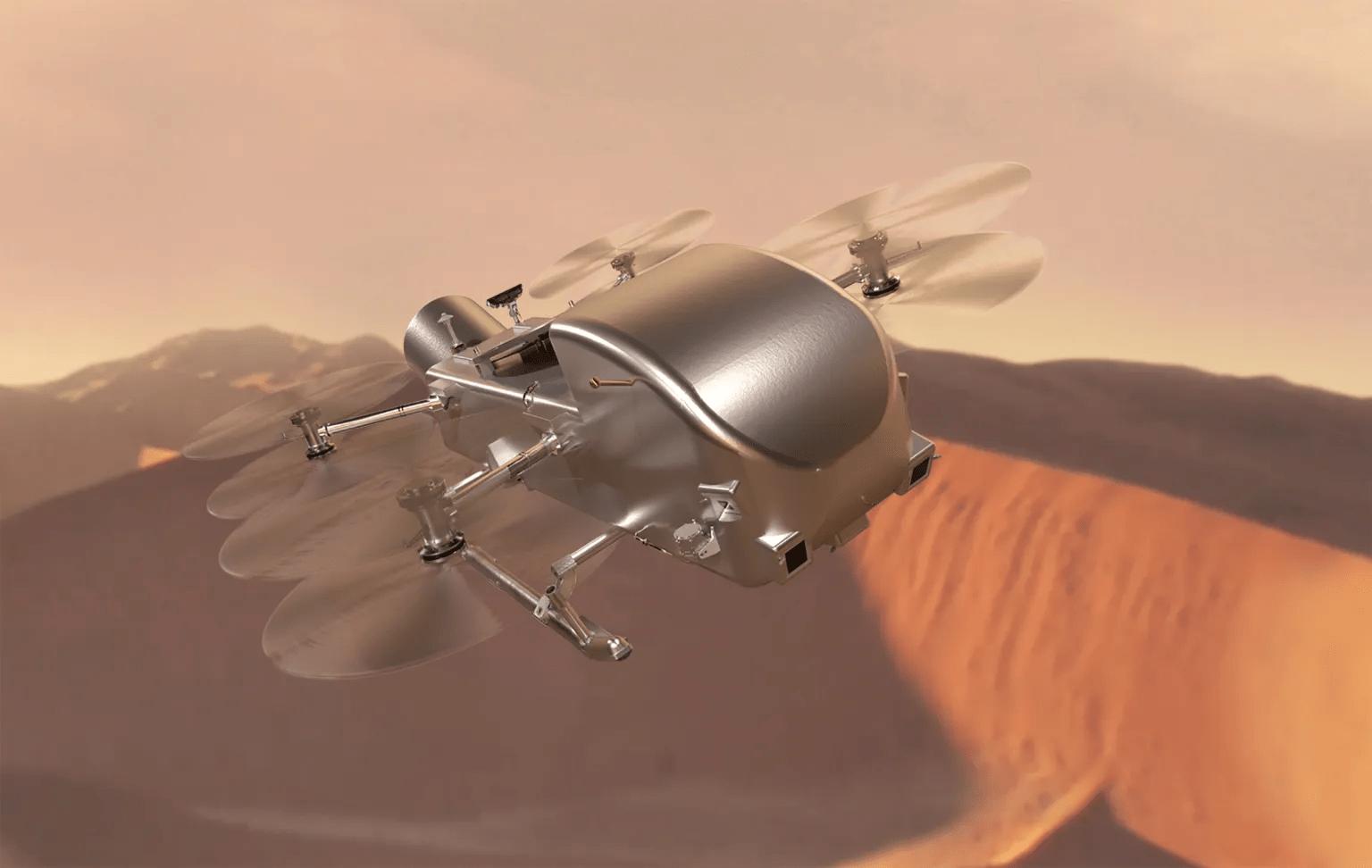
In early 2023, the mission successfully passed all the success criteria of its Preliminary Design Review. At that time, however, the mission was asked to develop an updated budget and schedule to fit into the current funding environment. This updated plan was presented and conditionally approved in November 2023, pending the outcome of the fiscal year 2025 budget process. In the meantime, the mission was authorized to proceed with work on final mission design and fabrication to ensure that the mission stayed on schedule.
With the release of the president’s fiscal year 2025 budget request, Dragonfly is confirmed with a total lifecycle cost of $3.35 billion and a launch date of July 2028. This reflects a cost increase of about two times the proposed cost and a delay of more than two years from when the mission was originally selected in 2019. Following that selection, NASA had to direct the project to replan multiple times due to funding constraints in fiscal years 2020 through 2022. The project incurred additional costs due to the COVID-19 pandemic, supply chain increases, and the results of an in-depth design iteration. To compensate for the delayed arrival at Titan, NASA also provided additional funding for a heavy-lift launch vehicle to shorten the mission’s cruise phase.
The rotorcraft, targeted to arrive at Titan in 2034, will fly to dozens of promising locations on the moon, looking for prebiotic chemical processes common on both Titan and the early Earth before life developed. Dragonfly marks the first time NASA will fly a vehicle for science on another planetary body. The rotorcraft has eight rotors and flies like a large drone.
Dragonfly is being designed and built under the direction of the Johns Hopkins Applied Physics Laboratory (APL) in Laurel, Maryland, which manages the mission for NASA. Elizabeth Turtle of APL is the principal investigator. The team includes key partners at NASA’s Goddard Space Flight Center; Lockheed Martin Space in Littleton, Colorado; NASA’s Ames Research Center; NASA’s Langley Research Center; Penn State University in State College, Pennsylvania; Malin Space Science Systems in San Diego, California; Honeybee Robotics in Pasadena, California; NASA’s Jet Propulsion Laboratory; CNES (Centre National d’Etudes Spatiales) in Paris; the German Aerospace Center (DLR) in Cologne, Germany; and JAXA (Japan Aerospace Exploration Agency) in Tokyo.
Dragonfly is the fourth mission in NASA’s New Frontiers Program, managed by NASA’s Marshall Space Flight Center for the agency’s Science Mission Directorate.
What's Your Reaction?








































